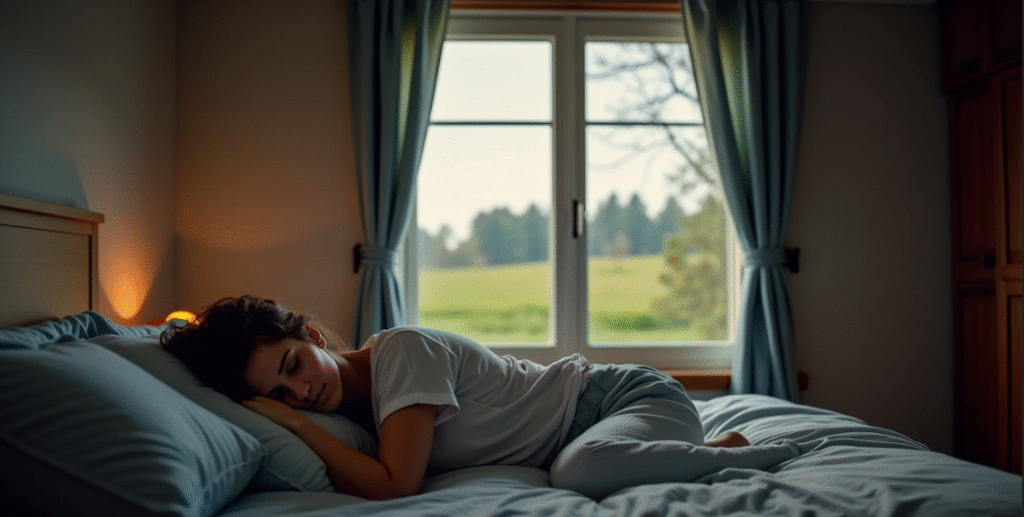Urban vs. Rural Sleep Recovery: Why Geography Shapes Recovery Nights
People in addiction recovery face different sleep challenges depending on where they live.
Sleep quality during addiction recovery in Georgia rural areas differs sharply from urban settings, driven by environmental factors, access to care, and community resources that either support or undermine the body’s ability to heal.
This article explains how urban heat, noise, treatment access gaps, and policy differences shape sleep outcomes across Georgia’s diverse communities.
Sleep Recovery Matters in Addiction Healing
Sleep is not just rest. It is the foundation for neurobehavioral recovery, cognitive repair, and homeostatic balance after substance use. When someone stops using drugs or alcohol, the brain needs consolidated, efficient sleep to reverse damage and restore function. Sleep recovery refers to the capacity to achieve restorative sleep that reverses impairments from prior sleep loss or fragmentation. Without quality sleep, people in recovery struggle with memory, decision making, and emotional regulation, all critical for maintaining sobriety.
Geography plays a decisive role in whether someone can get that restorative sleep. Urban and rural environments create different bedroom conditions, expose people to varying levels of pollution and noise, and offer unequal access to treatment that supports healthy sleep routines.
Addiction Recovery in Georgia Rural Areas
Rural Georgia presents distinct barriers to both addiction treatment and sleep recovery. Research shows that rural patients face lower rates of timely initiation and engagement in substance use disorder care compared with urban peers. When treatment is harder to access, recovery becomes more fragmented, and sleep suffers.
Transportation challenges force many rural residents to travel long distances for counseling, medication assisted treatment, or peer support meetings. These trips disrupt daily routines and compress the time available for rest. Additionally, rural communities often lack the density of pharmacies, clinicians, and recovery housing that urban areas enjoy, leaving people to manage withdrawal symptoms and early recovery without adequate support, conditions that directly degrade sleep continuity.
Telemedicine has emerged as a promising solution. Studies confirm that telemedicine enabled medications for opioid use disorder work as effectively as in person care and reduce travel burdens. For rural Georgians, telehealth offers a lifeline that can stabilize treatment and, by extension, improve sleep by reducing stress and logistical barriers.
Environmental Barriers to Sleep in Urban Georgia
Urban Georgia settings impose their own sleep obstacles, driven largely by environmental exposures that disrupt sleep continuity and efficiency. A multi exposure study found that elevated bedroom PM2.5, CO2, temperature, and noise each reduced sleep efficiency in dose dependent fashion, even after adjusting for behaviors and co-exposures. Urban bedrooms, especially in dense neighborhoods near highways, accumulate higher levels of traffic pollution, noise, and poor ventilation, all factors that prevent the deep, consolidated sleep the recovering brain requires.
Heat is another urban challenge. During summer months, urban heat islands elevate nighttime temperatures above surrounding areas. Research in Los Angeles showed indoor bedroom temperatures averaged about 5°C higher than outdoors at night, and a 5°C increase in indoor temperature was associated with 23 minutes less total sleep and roughly 4% lower sleep efficiency during heat waves. For someone in early recovery, already managing disrupted circadian rhythms and heightened stress, losing nearly half an hour of sleep per night can derail progress.
Lower income urban neighborhoods bear the brunt of these exposures. Older housing stock, limited air conditioning, and proximity to traffic corridors combine to create conditions where restorative sleep becomes nearly impossible during hot months. Without intervention, these environmental burdens translate into chronic sleep debt that undermines cognitive recovery and increases relapse risk.
Access Gaps and Insurance Coverage Differences
Coverage alone does not guarantee access. While Medicaid expansion significantly increased buprenorphine initiation in low income urban counties, rural counties saw no comparable benefit. This disparity persists because rural areas lack the provider networks, pharmacies, and peer support infrastructure needed to convert insurance into actual treatment engagement.
The gap matters for sleep. Medications such as buprenorphine stabilize withdrawal symptoms and cravings, allowing the nervous system to settle into more regular sleep wake cycles. When rural patients cannot initiate or sustain medication treatment due to access barriers, their sleep remains fragmented by discomfort and hyperarousal, physiological states incompatible with recovery.
Commercial insurance networks show similar patterns. Rural patients depend on out of network providers at rates at least as high as urban patients, especially for substance use disorders beyond opioids. Out of network care often means higher costs, longer waits, and less coordinated follow up, all of which disrupt the stable routines essential for healthy sleep.

Key Differences: Urban vs Rural Sleep Recovery
| Factor | Urban Impact | Rural Impact |
| Bedroom environment | Higher PM2.5, CO2, noise from traffic; heat island effect | Generally quieter, cooler nights; older homes may lack ventilation |
| Treatment access | More providers, pharmacies, recovery housing; Medicaid expansion narrowed income gaps | Fewer providers; travel barriers; Medicaid expansion did not reduce income disparities |
| Telemedicine | Reduces commute time; supports retention | Critical access tool; mitigates distance and workforce shortages |
| Community support | Dense peer networks, recovery residences, harm reduction services | Limited peer capacity; fewer recovery residences; higher stigma in small communities |
| Policy levers | Low emission zones, urban cooling, later school start times | Telehealth expansion, pharmacist prescribing authority, mobile treatment units |
Why Sleep Quality Predicts Recovery Outcomes?
Sleep efficiency, the percentage of time in bed actually spent asleep, directly correlates with neurobehavioral restitution. When sleep is fragmented by environmental noise, heat, or the physiological turmoil of untreated withdrawal, the brain cannot complete the slow wave and REM cycles necessary for memory consolidation, emotional regulation, and synaptic repair.
In predominantly rural counties, a study found that receipt of medications for opioid use disorder was associated with 24% lower emergency department visit rates and 52% lower inpatient admission rates over 30 months. While this study did not measure sleep directly, the reductions in acute care utilization suggest more stable health trajectories, conditions under which sleep quality likely improves as crisis episodes decline and daily routines stabilize.
Conversely, environments that systematically degrade sleep continuity impose a recovery penalty. Urban heat, pollution, and noise erode the restorative value of each hour in bed, effectively requiring more time asleep to achieve the same recovery benefit, a luxury few people in early recovery can afford given work, childcare, and treatment schedules.
Practical Steps to Improve Sleep Recovery
Improving sleep in addiction recovery requires addressing both the individual and the environment. Simple interventions can yield meaningful gains:
- Cool the bedroom: Use fans, open windows at night when safe, or seek cooling assistance programs during heat waves. Even a few degrees cooler can restore lost sleep minutes.
- Reduce noise and light: Earplugs, blackout curtains, or white noise machines buffer urban disturbances. In rural areas, address any indoor noise sources.
- Stabilize treatment: Whether through telehealth visits, local pharmacy partnerships, or peer support, consistent engagement with recovery services reduces the stress and uncertainty that fragment sleep.
- Improve ventilation: Open windows or use air purifiers to lower CO2 and particulate levels, especially in urban apartments or older rural homes with poor airflow.
- Align sleep schedules: Go to bed and wake at the same time daily to reinforce circadian rhythms disrupted by substance use.
Policy and System Changes That Work
States and communities can adopt evidence based strategies to support sleep recovery across urban and rural settings. Later school start times, while focused on adolescents, model how schedule policies can lengthen sleep opportunity, a principle applicable to work schedules and treatment program hours that currently force early morning commitments incompatible with recovery needs.
Urban areas benefit from low emission zones and traffic calming measures that reduce nighttime noise and air pollution, both of which improve sleep efficiency. Neighborhood tree planting and cool roof programs can lower indoor nighttime temperatures by several degrees, translating to better sleep during heat waves.

Rural areas require investment in telehealth infrastructure, pharmacists prescribing authority for medications like buprenorphine, and mobile treatment units that bring services closer to home. These supply side expansions reduce travel stress and stabilize daily routines, creating the predictability that supports healthy sleep.
Importantly, criminal legal systems must ensure continuity of medications during incarceration and after release. Interruptions in treatment restart the cycle of withdrawal and hyperarousal that destroys sleep and elevates overdose risk, a pattern that disproportionately harms rural communities with fewer reentry support.
Measurement Matters: Beyond Access to Outcomes
Current quality measures focus on treatment initiation and engagement, important but insufficient proxies for recovery. Sleep related outcomes and retention at six and twelve months offer more direct signals of whether interventions support the physiological healing required for sustained recovery. Payers and providers should track emergency department visits, hospital admissions, and self-reported sleep quality alongside traditional access metrics to capture the full picture of recovery trajectories across urban and rural populations.
Without measurement evolution, rural programs may appear underperforming simply because they face supply constraints beyond their control, masking the real question: are available services delivering restorative sleep and functional recovery for the people they reach?
Moving Forward Together
Urban and rural Georgians in addiction recovery deserve environments and systems that support restorative sleep. Urban settings must tackle heat, noise, and air quality while expanding affordable housing with better environmental controls. Rural areas need provider capacity, telehealth stability, and community recovery infrastructure that reduce isolation and logistical burdens.
Coverage matters, but it is not enough. Geography shapes recovery because it determines the bedroom you sleep in, the distance to your next counseling session, the noise outside your window, and the temperature when you try to rest. Closing these gaps requires coordinated action across housing policy, healthcare delivery, transportation, and community investment, targeted to the specific barriers each geography presents.
Sleep recovery after addiction in Georgia urban areas and sleep recovery after addiction in Georgia rural areas will look different in practice, but both can succeed with the right mix of environmental improvements, accessible treatment, and community support that recognize sleep as the foundation of healing.
If you or someone you care about is navigating addiction recovery and struggling with sleep, you do not have to manage it alone. Connect with Summit Mental Health Center, our addiction counseling services understand the whole picture of recovery.


